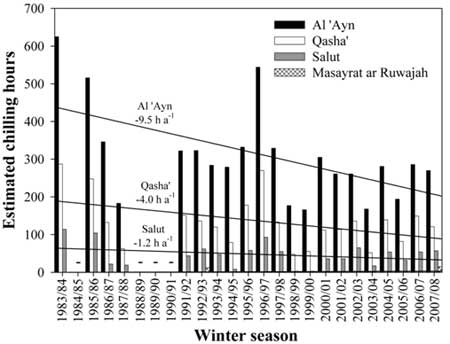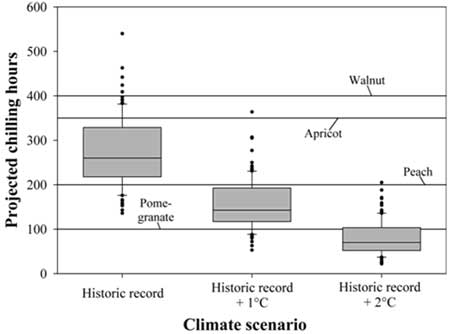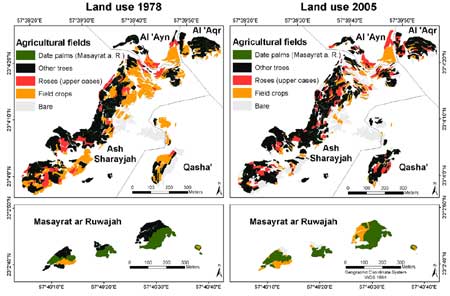 |
| Archaeology |
| History |
| Urban Planning |
| Agriculture |
| Landscape Ecology |
 |
Effects of agro-enviromental changes on oasis cropping systems Objectives: Determine the effects of land use and climatic changes on the sustainability of high-altitude oases Contact Person: Prof. Dr. Andreas Bürkertand Prof. Dr. Eva Schlecht, Institute of Crop Science, University of Kassel, Germany Email: [email protected] Scientific staff: Dr. Eike Luedeling, Dr. Stefan Siebert Study area: Northern Oman Duration: 2005-2007 Susceptibility of mountain oases to changing climatic change The crop composition of high-altitude oases of Al Jabal al Akhdar is markedly different from that of lowland oases. Instead of date palms, the terraces belonging to these settlements feature tree crops more typically found in temperate and cool subtropical regions, such as pomegranates, peaches, apricots and walnuts. All of these tree species depend on the occurrence of cool temperatures in the winter to break their dormancy and initiate fruiting. These so-called chilling requirements are typically quantified in Chilling Hours by summing up the number of hours during the winter, when temperatures range between 0 and 7°C. The unique compositions of the orchards of Al Jabal al Akhdar, and the inability of lowland farmers to grow the same tree crops indicates that these high-altitude systems lie in an environmentally marginally location for the cultivation of these crops. Consequently, they might be vulnerable to climatic change.
The number of Chilling Hours appeared to be on the decline in Oman’s high altitude oases over the period of this study (1983-2008; Figure 2). Chilling requirements of most tree crops were not met in most years at the lower oases, while at Al ‘Ayn, the hghest oasis, conditions were still sufficiently cold for most trees. Both future scenarios, however, indicated that chilling conditions are likely to become marginal to insufficient even at this location (Figure 3). It should be noted that the exact chilling requirements of the varieties cultivated in Oman are unknown, and that under the prevailing temperature conditions in the oases, Chilling Hours might not be a good indicator of winter chill (Luedeling et al., in preparation).
Influence of land use changes on hydrological sustainability To accommodate inevitable interannual fluctuations in their water supply, oasis farmers in Oman typically cultivate annual crops on some of their terraces, in addition to the perennials that provide the majority of food and fiber. In years of limited water availability, these fields can be left uncultivated, allowing farmers to conserve water without affecting their valuable date palm or pomegranate orchards. This traditional practice indicates that the proportion of the oasis that is cropped with annual crops is an indicator of the stability of an oasis’ water supply, and that changes to this proportion might put oasis sustainability at risk.
Land use changed substantially in some oases, especially at Qasha’, where most of the former cereal plots were converted to orchards. Similar changes occurred in parts of Ash Sharayjah, while at Masayrat ar Ruwajah, most of the former lime orchard was converted to annual crops (Figure 4). The net balance of these changes was favorable for Masayrat ar Ruwajah and Al ‘Ayn, where more water was dedicated to annual crops in 2005 than in 1978. For the other oases, the proportion of orchard vs. field crops increased during this period, indicating that oasis resilience to water scarcity had decreased substantially. Especially at Qasha’ and Al ‘Aqr, spring flow now appeared insufficient to reliably supply irrigation water to all fields (Figure 5). Additional pressure on regional water resources is likely to originate from increased domestic water consumption in the oasis and the new town of Sayh Qatanah, as well as from newly developed tourism infrastructure.
Publications |
|||||||




